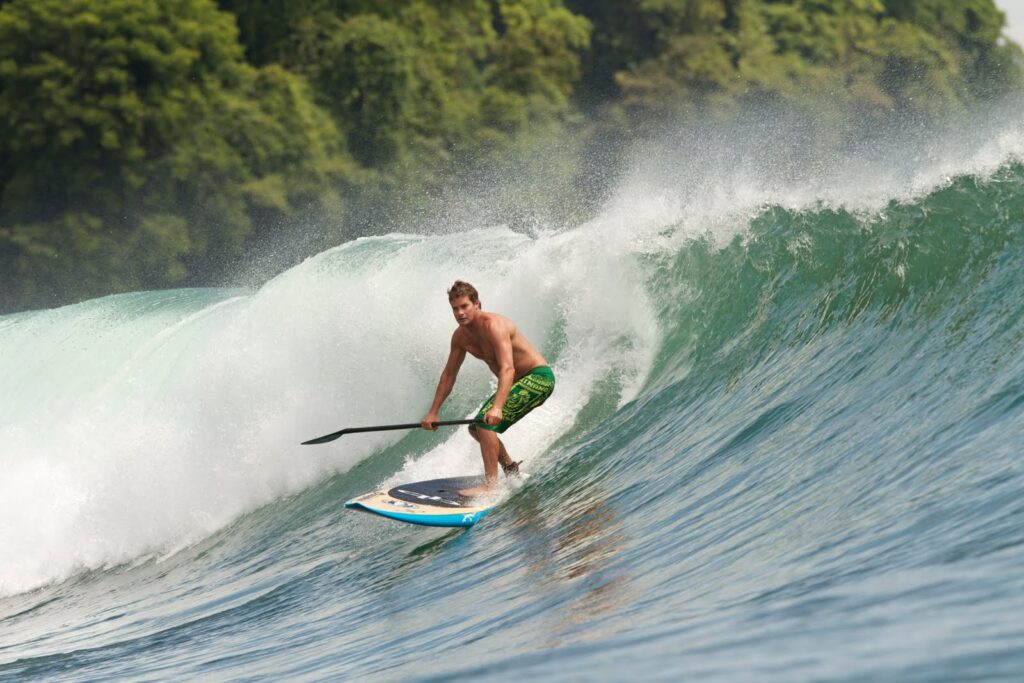Uncategorized
How to Start SUP Surfing
The sun is bright and bouncing off the water. The wind is calm. And the salt air touches your lips. As you wait patiently in the water, you see a wave crest on the horizon. It’s building.
You glance backwards, as you position your feet and begin to paddle. The peak takes shape and you’re in the right spot. It’s a perfect left. You take one last glance behind you and paddle hard.
Suddenly, the board lifts and you feel the energy underneath your feet. One last paddle and you sink into the crest of the wave. You switch stances and execute a bottom turn. The same motion you’ve completed time and time again.
It’s smooth. The wave’s energy propels you forward. You pick up speed. One small motion with your paddle and you turn into the breaking wave, pop off the lip, and shoot back down the face as you zip past the shoreline.
You make it out the other side. Dry. The adrenaline seeps through your bones and you feel…
Alive.
This is what it feels like to catch wave after wave on your SUP. It’s something every SUP fanatic should take the time to learn and experience themselves.
But it can also be difficult to get started. There are many facets of SUP surfing that make it challenging for the flat water paddler. To help push you in the right direction, we’ve decided to create this short guide on how to get started in SUP surfing.
What is SUP Surfing?
The answer is simple. And it lies right in the name. SUP surfing is the act of surfing your stand up paddle board in waves on the ocean.
It also happens to be an exhilarating activity that leaves most people craving for more. Especially on days when the waves are just right. And the crowds are thin.
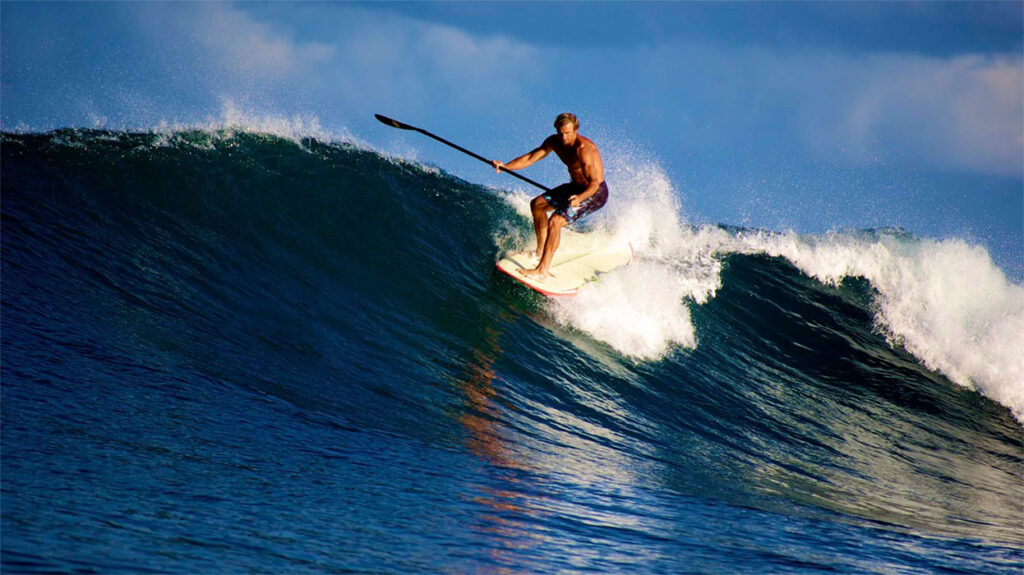
How is it Different From Prone Surfing?
Once you are on the wave, the main action of SUP surfing is very similar to standard prone surfing. Simply put, you are riding the waves’ energy along the shoreline to gather speed and produce the euphoric high from an exciting ride.
Other than that, the differences are plenty.
First, you’re already standing on a SUP when you’re on the ocean. This point of view makes it much easier to see waves building in the distance.
Along with this point of view, you also have a paddle instead of using your hands to move through the water. This can make it quicker to turn into a wave, but can also be more cumbersome if you are not familiar with using a paddle in this way.
In addition, instead of laying down and popping up when you feel the momentum of the wave, you switch from a forward stance to a sideways surfing stance when you feel yourself drop in.
And last, your board is much bigger and heavier when you use a SUP surfboard instead of a regular surfboard. And that includes being bigger than most longboards as well.
Due to the size and weight of a SUP surfboard, you should always exercise extra caution, especially in a crowded lineup.
The Main Gear
There are three main pieces of gear you will need to have a successful SUP surfing session.
Board
SUP surfboards come in a variety of shapes and sizes. Some paddlers enjoy using their flatwater boards for smaller waves, while others prefer a more high-performance board for bigger waves and fast-action surfing.
There are a few stipulations you should pay attention to when choosing a board to SUP surf on.
It shouldn’t be any longer than 11’. Anything more and you’ll likely bury the nose on every wave until you get more experience. Ideally, you want one that measures in at around 8’-9’ in length. This size will be the easiest to maneuver on the water.
Second, you should have one that will be able to float your weight with ease. If it’s your first time and you’re stuck on a board that is difficult to balance on — you’ll spend more time falling off than even coming close to catching a wave.
And if you’re just starting out, grab a board that is at least 30’’-31’’ in width. When it comes to standing on the ocean, balance in key. Some high-performance SUP surfboards can be very tiny in size. While you might feel confident in your abilities, always start on a board that will ensure your ability to stand on the ocean.
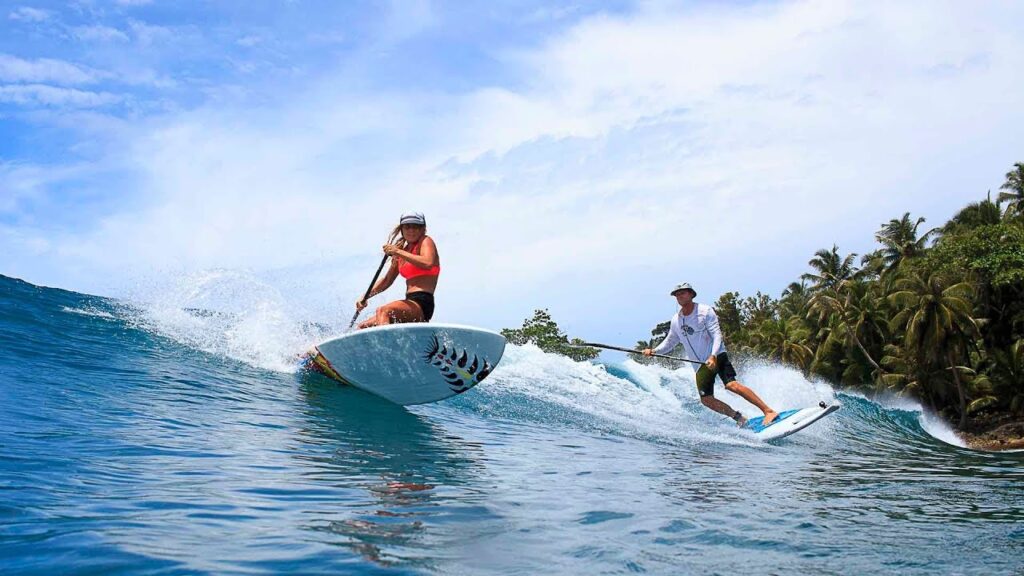
Paddle
For beginners, any paddle will do. As long as you can size it correctly for your body, then you’re good to go.
However, if you want the ultimate experience on the ocean, then you’ll likely want to grab a carbon fiber paddle. These paddles are the lightest ones available which is a very important factor when it comes to paddling hard to get through the white water, or to catch a wave.
A heavy paddle will burn your arms out quickly. And you’re likely to miss out on a few waves.
In addition, you want a paddle with the smallest blade possible. On the flatwater, medium sized blades work great for long distance paddles by moving the most amount of water as possible through each stroke.
On the ocean, none of that matters. Instead, what you want is speed, speed, speed. The quicker your stroke, the quicker you’ll be able to drop into a wave. To increase your speed, a smaller blade is much easier to use.
Leash
As we’ve already stated, SUP surfboards are big. Much bigger than 99% of surfboards. With such a bigger platform comes the need for a thicker leash. A good measure is to always match your leash with the size of your board. The bigger and thicker your board, the thicker a leash you will need to make sure it doesn’t snap when it’s taken by a wave.
You should also have a leash that is at least 10’ long. With a leash this length, you won’t have any problems with a board coming back on recoil after the whitewater has passed.
The last thing you want is to see your SUP surfboard coming back at you with a ton of speed directly towards your face!
Getting Started
Now that we’ve covered the basics on gear, it’s time to learn how to catch your first wave.
The Best Way to Be Successful
Besides a river with rapids, the ocean might be the most difficult environment to paddle on. The movement, the energy, the wind, the waves, the weather, the tides — they all combine to create an uneven surface of water that can be a difficult place to master.
On top of that, if you haven’t spent a ton of time in the ocean, the likelihood that you’ll be able to read a wave, know where to take off from, and how to exit (not to mention what it feels like to be propelled forward by a wave) is slim.
And then put on top of that the fact that you will be paddling a large watercraft with the ability to cause some serious damage to yourself or other surfers in the water, and you can understand why some SUP surfers get a bad rap.
If you can’t control your board, it can be very dangerous.
To remedy this situation, and save yourself from any onshore fist fights, we suggest learning how to bodysurf before trying SUP surfing.
It might seem counterintuitive, but it’s actually the smartest and safest thing you can do.
When you body surf, you learn how to read a wave. You understand when to start paddling to catch it. You will know what it feels like to be propelled forward by a wave. How to turn. How to duckdive. Where the wave is heading. And how it feels to be pushed over the falls for the first time (side tip: you can hold your breath a lot longer than you think, when you go over the falls, remain calm and allow the wave to pass overhead).
With this experience in hand, you’ll be better prepared for whatever may come on your SUP surfboard!
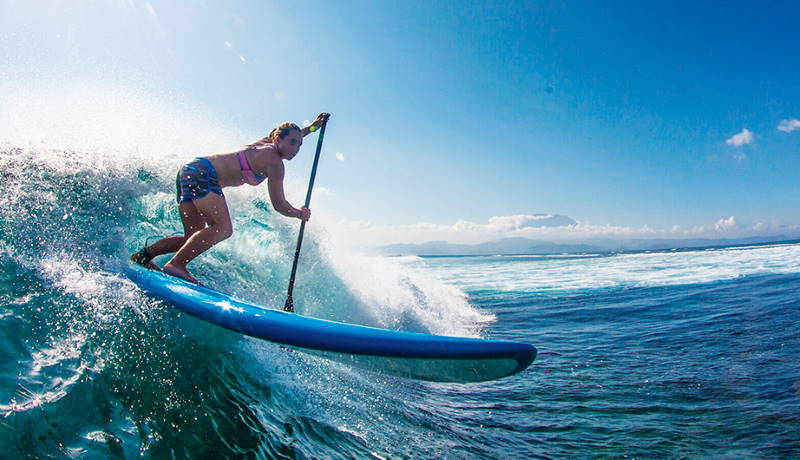
Where to Try It?
Have you had a few bodysurfing sessions and you’re ready to give it a go? Then you need the right day and the right environment.
For your first session, keep an eye on the surf reports. Three great resources include:
On these websites, you’ll be able to look up your local break and find information on the wind, the waves, what wetsuit to wear, and what board might be best for the day. The green color is an indicator that it’s the best time to go.
Always start on a day that is 1’-2’ in size with minimal wind. This size is manageable to get past the whitewater with ease. And if you do catch a wave, the energy behind it won’t be enough to cause any bodily harm if (when) you fall off.
In addition, you always want to begin your SUP surfing journey at a site that has a sandy bottom.
Surf breaks have bottoms of sand, rock, or coral. Obviously, the latter two options can include an added risk of cuts or broken bones. With a soft sandy bottom you’ll be able to touch the bottom with your feet without the risk of injury.
So, to summarize, always choose a place that has a soft, sandy bottom. And choose a day that is 1’-2’ in size with minimal wind.
This will ensure your safety and your fun on the water for your first time!
What to Avoid
As we’ve already stated, avoid any coral or rocky bottoms. This alone will make your time on the water much safer.
Beyond that though, there is one thing you should always avoid if you are a true beginner…
Crowds.
Avoid any crowded lineups full of surfers or SUP surfers.
Why? Well, first, surfers can be territorial. If they find a wave they like, they’re having a great time, then they are likely not in the mood to share. Especially to a beginner on a SUP surfboard.
Also, if you are still unable to control your board in a safe way, accidents can happen where your big SUP surfboard can get loose in the lineup and that is dangerous for the other surfers around you.
Last, there is a surfing etiquette you must follow on the waves. You can’t cut in line if people are waiting for a wave. And you definitely cannot drop into a wave that a surfer is currently on. This is a big no-no.
We don’t plan on covering the entire surfing etiquette handbook in this post — for more information head HERE.
In short, to avoid any problems with anyone on or off the water, pick a spot that isn’t crowded and you’re likely to have a much better (and safer) time on the water.
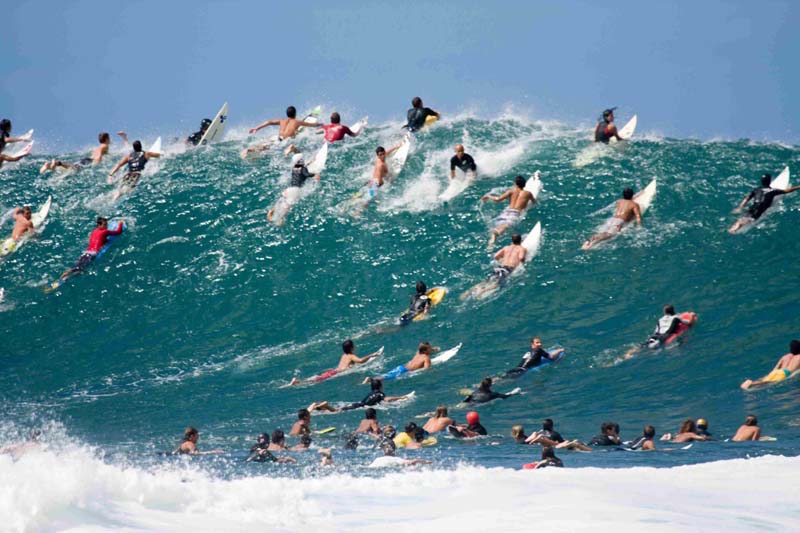
The Paddle Stance vs. The Surfing Stance
Once you’re on the ocean, you’re feeling comfortable, you’re able to stand up and paddle, it’s time to catch your first wave.
The sequence to do this is often as follows…
You see a wave building on the horizon. You see the peak. It looks like a perfect left breaking wave. This means as you face the shoreline you’ll be moving left on the wave.
You paddle quickly with your feet facing forward in a natural paddling position. You dig deep with your blade matching the speed of your board with the building wave.
As you take one last look back you see it crest at its apex and you give one last push. The board lifts slightly and the energy of the wave pushed you down into the drop. As you drop in, you switch your stance from a forward facing position to a surf style position with one foot in front of the other.
And now, you have the entire wave to surf in front of you.
Sounds easy enough, doesn’t it? Well, there is one last thing you should know before you head onto the water…
Your surf stance.
Goofy Foot
If you are goofy, you have your right foot forward and your left foot back towards the tail.
Regular Foot
If you are regular, you have your left foot forward and your right foot back towards the tail.

Of course, if you’re not sure whether you are goofy or regular, the best thing you can do is practice each stance while on flatwater. See which way is more comfortable for you. Move from a forward facing stance to a surf style stance. Then back and forth between the two styles.
As you move around on your board you will come to learn what style is yours. Just remember to use the correct one while you’re catching your first wave!
Conclusion
With all of these tips, tricks, and gear lists, you should now be mentally prepared for your first SUP surfing session.
Of course, often the best way to be successful on the water no matter the environment or the activity is by taking a beginner lesson with a qualified SUP instructor. This is no different when it comes to SUP surfing!
If you’re interested in lessons, tips, tricks, or want to take a look at our inventory full of SUP surf boards, then contact us directly. The team at Walk on Water is always here to get you paddling on the water!
